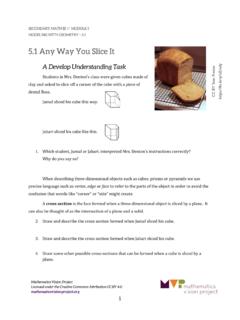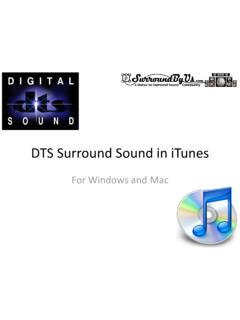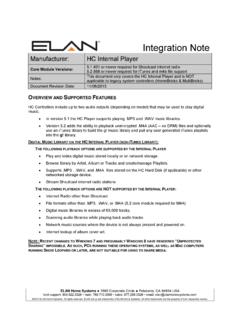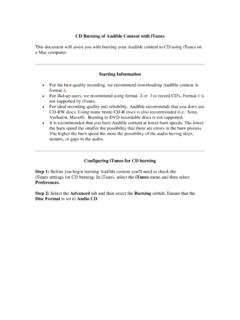Transcription of iTunes: A Basic Tutorial - Utah Education Network
1 1 iTunes: A Basic Tutorial Taken from iLife 06 Multimedia tutorials Topic Page Installing iTunes and Getting Started 02 Importing Music from CDs 03 Playing Your Music in iTunes 04 Browsing and Searching Your iTunes Library 05 Using Playlists to Organize Your Music 06 Creating Smart Playlists 07 Fixing or Changing Song Information 08 Burning Your Music to a CD 09 Subscribing and
2 Listening to Podcasts 10 2 Installing iTunes and Getting Started iTunes can play your favorite CDs, but you can also import your songs into your iTunes Library. Once imported, you'll be able to arrange your songs into playlists, share them with your other computers using iTunes, or take them with you on your iPod. iTunes is a free download for both Mac and Windows. Steps Install iTunes on your computer. 1. Go to 2. Choose Mac OS X or Windows 2000/XP. 3. Click the Download iTunes button. Windows 2000/XP: Run the iTunes Setup program, then follow the instructions to complete the installation. Open iTunes from Start > Programs > iTunes > iTunes. Mac OS X: Follow the instructions to complete the installation, then click the iTunes icon in your dock to open it.
3 4. Opening iTunes Preferences. On a Windows computer, you can find iTunes Preferences by going to the Edit menu and selecting Preferences. On a Mac, you can find iTunes Preferences by going to the iTunes menu and selecting Preferences. 3 Importing Music from CDs iTunes can play your favorite CDs, but you can also import your songs into your iTunes library so you ll be able to arrange your songs into playlists, share them with your other computers using iTunes, or take them with you on your iPod. When you import your music, iTunes copies the songs from your CDs to your computer, and then converts each song to a small file that iTunes and your iPod can play. Steps Copy music from a CD to iTunes. 1. Open iTunes, and then insert a music CD into your computer.
4 2. Click the CD name in the Source list to see the songs on the CD. 3. Uncheck any songs you don t want to import. Only checked songs will be imported. 4. After you decide which songs to import, click the Import CD button in the upper right corner. iTunes will begin copying the music from your CD to your iTunes Library. After all the songs are imported, click the Eject Disc button in the bottom right corner. 4 Playing Your Music in iTunes iTunes has simple controls that allow you to choose which song you want to play, control a song s volume, and skip ahead to another song. The display in iTunes will show you the name of the artist, the song title, and the length of the song. Steps Play a song from your iTunes Library. 1. Select Library in the Source list to view all the music you have in iTunes.
5 2. Select any song in the list, and then click the Play button in the upper-left corner. 3. To change the volume, drag the volume slider to the right or left. 4. Click anywhere in the progress bar in the display area to skip to a different point in your song. The diamond playhead icon indicates where you are in the song. 5. Click and hold the Next Song button to fast-forward to a different point in your song, or click and hold the Previous Song button to skip back to a previous point in your song. Click the Next Song button to skip to the next song in your library, or click the Previous Song button to go back to previous songs that you ve listened to. 5 Browsing and Searching Your iTunes Library Looking around your music library is easy in iTunes.
6 With the Browse feature in iTunes, you can quickly see all the genres, artists and albums in your collection. Steps Find songs in your music library. 1. Select Library in the Source list. 2. Click the Browse button in the upper-right corner of the iTunes window. 3. Select an artist in the Artist list. Albums displayed to the right are albums by the selected artist. 4. Click the Browse button to close the browser and return to your iTunes library. 5. Type a word (or words) in the Search field in the upper right corner of the iTunes window to quickly find songs, artists, or albums that match your entry. Notice how the songs displayed in the iTunes window update as you type more letters in the Search field. 6. Narrow your search by song type with the buttons in the Search Bar, just above your list of songs.
7 You can also choose to choose to search by artist, album, or song name. To return to the iTunes window and display all the music in your library, click the icon on the right of the Search field. 6 Using Playlists to Organize Your Music When you want to create your own compilation, you can create playlists in iTunes. With a playlist, you choose which songs to play and the order in which to play them. Make a playlist with great songs for working out, going on a road trip, or dancing at your next party. Steps Create a custom playlist. 1. From the File menu, choose New Playlist, or click the Add (+) button in the lower-left corner of the iTunes window. An untitled playlist with a musical note icon appears in the iTunes Source list. 2. With the untitled playlist selected, give your playlist a title.
8 3. Select a song in your Library and drag it to your playlist. 4. Add as many songs as you want to your playlist. 5. Select multiple songs on a Windows computer by holding the Control key as you select songs. You can select a range of songs by clicking the first song, then holding the Shift key as you click the last song in a range. On a Mac, you can add multiple songs at once by holding down the Command key as you select songs in your library. 6. Click the playlist in the Source list to view all the songs you ve added. 7. To change the order of songs in the playlist, just drag the song to where you want. 8. To remove a song from a playlist, select it, and then press the Delete key. This does not delete your song from your library, it only removes it from your playlist.
9 9. If you want to keep a song in your playlist, but you don t want to listen to it or burn it to CD right now, click the checkbox next to the song. Your song will stay in your playlist, but won t be played the next time you listen to your playlist. 7 Creating Smart Playlists Creating playlists by hand is great when you want to pick specific songs for your mix, but with Smart Playlists, you can have iTunes automatically fill your playlist based on the rules you choose. For example, you can make a Smart Playlist of jazz music, your highest rated songs, songs you haven t played in a long time, or songs that you ve recently purchased. Steps Create a Smart Playlist of your favorite rock songs. 1. From the File menu, choose New Smart Playlist. 2. Choose "Genre" from the first pop-up menu.
10 3. Choose "contains" from the next pop-up menu. 4. Type "Rock" in the field provided. Notice as you type, genres in your library are filled in for you. 5. Click the + button to add a new rule. 6. Choose "My Rating" from the first pop-up menu. 7. Choose "is greater than" from the next pop-up menu. 8. Select a rating of three stars by clicking the third dot in the field provided. With this rule, iTunes will select songs that you ve rated with four or five stars. 9. If you want to limit your playlist to a certain number of songs, ensure the "Limit to" option is checked and type the number of songs you want. 10. Ensure "Live updating" is checked, and then click OK. 8 Fixing or Changing Song Information When you import music to your iTunes library, there is a lot of information included with the song file.



















